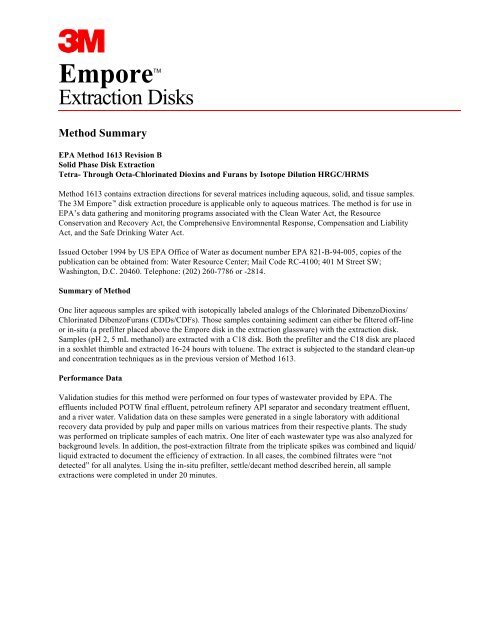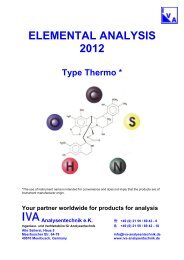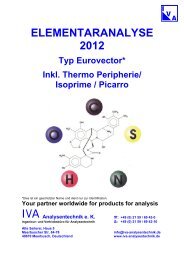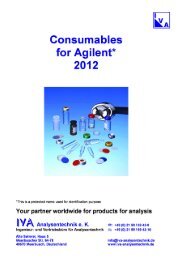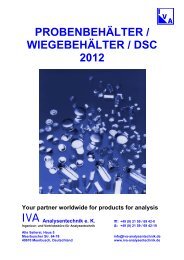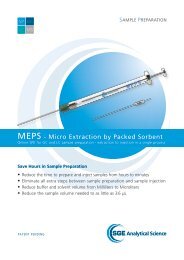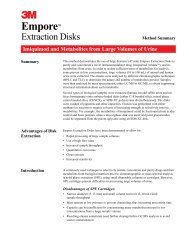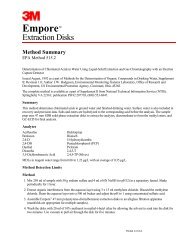EPA 1613 Revision B - IVA-Analysentechnik
EPA 1613 Revision B - IVA-Analysentechnik
EPA 1613 Revision B - IVA-Analysentechnik
You also want an ePaper? Increase the reach of your titles
YUMPU automatically turns print PDFs into web optimized ePapers that Google loves.
EmporeTM<br />
Extraction Disks<br />
Method Summary<br />
<strong>EPA</strong> Method <strong>1613</strong> <strong>Revision</strong> B<br />
Solid Phase Disk Extraction<br />
Tetra- Through Octa-Chlorinated Dioxins and Furans by Isotope Dilution HRGC/HRMS<br />
Method <strong>1613</strong> contains extraction directions for several matrices including aqueous, solid, and tissue samples.<br />
The 3M Empore TM<br />
disk extraction procedure is applicable only to aqueous matrices. The method is for use in<br />
<strong>EPA</strong>’s data gathering and monitoring programs associated with the Clean Water Act, the Resource<br />
Conservation and Recovery Act, the Comprehensive Enviromnental Response, Compensation and Liability<br />
Act, and the Safe Drinking Water Act.<br />
Issued October 1994 by US <strong>EPA</strong> Office of Water as document number <strong>EPA</strong> 821-B-94-005, copies of the<br />
publication can be obtained from: Water Resource Center; Mail Code RC-4100; 401 M Street SW;<br />
Washington, D.C. 20460. Telephone: (202) 260-7786 or -2814.<br />
Summary of Method<br />
Onc liter aqueous samples are spiked with isotopically labeled analogs of the Chlorinated DibenzoDioxins/<br />
Chlorinated DibenzoFurans (CDDs/CDFs). Those samples containing sediment can either be filtered off-line<br />
or in-situ (a prefilter placed above the Empore disk in the extraction glassware) with the extraction disk.<br />
Samples (pH 2, 5 mL methanol) are extracted with a C18 disk. Both the prefilter and the C18 disk are placed<br />
in a soxhlet thimble and extracted 16-24 hours with toluene. The extract is subjected to the standard clean-up<br />
and concentration techniques as in the previous version of Method <strong>1613</strong>.<br />
Performance Data<br />
Validation studies for this method were performed on four types of wastewater provided by <strong>EPA</strong>. The<br />
effluents included POTW final effluent, petroleum refinery API separator and secondary treatment effluent,<br />
and a river water. Validation data on these samples were generated in a single laboratory with additional<br />
recovery data provided by pulp and paper mills on various matrices from their respective plants. The study<br />
was performed on triplicate samples of each matrix. One liter of each wastewater type was also analyzed for<br />
background levels. In addition, the post-extraction filtrate from the triplicate spikes was combined and liquid/<br />
liquid extracted to document the efficiency of extraction. In all cases, the combined filtrates were “not<br />
detected” for all analytes. Using the in-situ prefilter, settle/decant method described herein, all sample<br />
extractions were completed in under 20 minutes.
Validation Data<br />
Refinery Effluent<br />
Spike POTW River<br />
Level Effluent API Final Water<br />
Analyte pg/L %R (RSD) %R (RSD) %R (RSD) %R (RSD)<br />
Native<br />
2378-TCDD 200 101 (5.7) 109 (11) 110 (5.6) 112 (2.6)<br />
12378-PeCDD 1000 88 (1.0) 110 (9.1) 110 (0.6) 115 (1.5)<br />
123478-HxCDD 1000 99 (9.0) 114 (4.9) 108 (2.5) 116 (1.5)<br />
123678-HxCDD 1000 99 (9.0) 105 (3.0) 106 (1.5) 123 (2.6)<br />
123789-HxCDD 1000 99 (5.6) 118 (15) 109 (1.5) 115 (6.1)<br />
1234678-HpCDD 1000 102 (4.9) 112 (4.2) 108 (0.6) 110 (2.1)<br />
OCDD 2000 111 (3.6) B 119 (3.5) B 119 (2.6) B 116 (1.0)<br />
12378-PeCDF 1000 90 (1.7) 115 (6.8) 111 (1.5) 116 (0.6)<br />
23478-PeCDF 1000 98 (4.0) 113 (6.6) 111 (2.7) 114 (1.0)<br />
123478-HxCDF 1000 100 (3.6) 110 (6.0) 108 (6.0) 118 (0.6)<br />
123678-HxCDF 1000 100 (5.0) 110 (2.6) 105 (2.1) 116 (1.0)<br />
234678-HxCDF 1000 94 (1.7) 108 (2.5) 101 (1.5) 114 (1.0)<br />
123789-HxCDF 1000 95 (4.2) 107 (5.0) 104 (2.1) 118 (2.6)<br />
1234678-HpCDF 1000 B 110 (2.1) 109 (8.6) 100 (3.0) 119 (2.0)<br />
1234789-HpCDF 1000 103 (4.0) 106 (10) 100 (1.5) 119 (2.0)<br />
OCDF 2000 105 (9.8) 119 (13) 115 (3.5) 119 (7.2)<br />
Other Standards<br />
37C1 -TCDD 62 (6.2) 64 (1.8) 71 (9.1) 63 (1.5)<br />
Internal Standards<br />
13C12-2378-TCDD 56 (6.7) 64 (2.8) 71 (8.5) 59 (1.9)<br />
13C12-PeCDD 123 82 (12) 61 (12) 72 (15) 83 (5.0)<br />
13C12-HxCDD 478 76 (2.9) 87 (18) 99 (5.2) 80 (4.2)<br />
13C12-HxCDD 678 72 (2.3) 70 (12) 76 (5.0) 76 (2.5)<br />
13C12-HpCDD 678 71 (4.2) 87 (6.7) 83 (20) 83 (2.6)<br />
13C12-OCDD 69 (6.0) 80 (14) 86 (4.9) 79 (8.4)<br />
13C12-PeCDF 123 67 (7.2) 61 (9.3) 77 (13) 74 (3.4)<br />
13C12-PeCDF 234 61 (5.3) 63 (9.3) 79 (14) 80 (4.7)<br />
13C12-HxCDF 478 82 (7.2) 81 (14) 96 (1.8) 71 (6.8)<br />
13C12-HxCDF 678 69 (4.0) 72 (6.4) 79 (1.4) 69 (6.3)<br />
13C12-HxCDF 234 80 (2.4) 76 (7.3) 85 (1.4) 73 (0.9)<br />
13C12-HxCDF 789 73 (1.6) 78 (7.7) 85 (5.7) 75 (1.4)<br />
13C12-HpCDF 678 63 (2.5) 78 (9.4) 77 (14) 69 (11)<br />
13C12-HpCDF789 68 (1.1) 85 (5.7) 80 (20) 81 (2.4)<br />
B = Present in Blank Sample<br />
n = 3<br />
2,3,7,8-TCDF Not Determined<br />
Average Recovery Native Compounds = 109%
Method<br />
1. This extraction option is applicable only to aqueous samples. Measure sample volume. Add isotopically<br />
labeled analogs, 5 mL methanol, and pH to 2. Allow the sample to sit and the sediment settle as much as<br />
is practical.<br />
2. Assemble an all glass filtration assembly using a 90 mm 3M Empore TM<br />
extraction disk containing C18.<br />
For samples with no particulates, a 47mm disk can be used. Use of a manifold for multiple extractions is<br />
acceptable.<br />
2. If samples contain significant quantities of particulates, the use of an in-situ glass micro-fiber prefilter (Whatman GMF 150, 1<br />
micron pore size or equivalent) is advisable. The glass fiber prefilter is placed on top of the Empore disk prior to placement of the<br />
glass reservoir and clamp.<br />
3. Prewash. Wash the extraction apparatus and disk by adding 15 mL of toluene to the reservoir washing<br />
down the sides of the glass reservoir in the process. Pull a small amount through the disk with a vacuum;<br />
turn off the vacuum and allow the disk to soak for about one minute. Pull the remaining solvent through<br />
the disk and allow the disk to dry. Repeat the wash step using 15 mL of acetone.<br />
4. Condition. Pre-wet the disk by adding 15 mL methanol (MeOH) to the reservoir, pulling a small amount<br />
through the disk then letting it soak for about one minute. Pull most of the remaining MeOH through the<br />
disk, leaving 3-5 mm on the surface of the disk, which should not be allowed to go dry from this point<br />
until the sample extraction has been completed. THIS IS A CRITICAL STEP FOR A UNIFORM FLOW<br />
AND GOOD RECOVERY. The disk is composed of hydrophobic materials. To make them amenable to<br />
a water solution, they must be pre-wetted with a water miscible solvent (MeOH) or they will not allow<br />
water to pass through the materials. Should the material accidentally dry before the sample is added,<br />
simply repeat the pre-wetting step.<br />
5. Rinse the disk by adding 50 mL of reagent water to the disk and drawing most through, again leaving 3-5<br />
mm of watcr on the surface of the disk. Repeat using a second 50 mL aliquot of water.<br />
6. Extraction. Add the water sample to the reservoir and, under full vacuum, filter as quickly as the<br />
vacuum will allow. Drain as much water from sample bottle as possible. Particulate-free water may pass<br />
through the disk in as little as 10 minutes without reducing analyte recoveries. Allow the entire sample to<br />
pass through the disk then dry the disk by maintaining vacuum for about 3 minutes.<br />
2. With heavily particle-laden samples, allow the sediment to settle, decant as much liquid as is practical into the reservoir. Allow<br />
most of thc liquid to filter then swirl the sediment portion and add it to the reservoir. Before the entire sample has filtered, rinse the<br />
sample bottle with reagent water and add to the reservoir to transfer any particulates remaining in the bottle to the extraction. Drain<br />
as much water as possible from the sample bottle.<br />
7. Disassemble the extraction glassware and carefully transfer both the Empore disk and the particle-laden<br />
GMF filter to the thimble of a Soxhlet Dean-Stark apparatus. Place a glass wool plug over the filters.<br />
Add about 50 mL toluene to the sample bottle, replace the cap and agitate well to rinse all remaining<br />
residues into the toluene. Transfer the toluene to the Soxhlet aparatus. Repeat the bottle rinse three times.<br />
Using 10 mL toluene, rinse the extraction glassware reservoir and transfer to the Soxhlet.<br />
8. Soxhlet extract for 16 - 24 hours. The data for this validation was generated using a 16 hour Soxhlet<br />
extraction.<br />
9. Concentrate sample and proceed to clean-up and analysis as per the Method <strong>1613</strong> directions.
IMPORTANT NOTICE TO PURCHASER<br />
All statements, technical information and recommendations contained in this literature are based on tests conducted with 3M<br />
approved equipment and are believed to be reliable. However, the accuracy or completeness of the tests are not guaranteed. THE<br />
FOLLOWING IS MADE IN LIEU OF ALL WARRANTIES, EXPRESS OR IMPLIED, INCLUDING THE IMPLIED<br />
WARRANTIES OF MERCHANTABILITY AND FITNESS FOR A PARTICULAR PURPOSE: The seller’s and manufacturer’s<br />
only obligation will be to replace the quantity of the product proved to be defective. Neither the seller nor 3M will be liable for any<br />
injury, loss or damage, direct or consequential, arising out of the use of or the inability to use the product. Before using, the user must<br />
determine the suitability of the product for his or her intended use.<br />
New Products Department<br />
3M Industrial and Consumer Sector<br />
3M Center, Building 220-9E-10<br />
St. Paul, MN 55144-1000<br />
800 328 5921<br />
7 8 - 6 9 0 0 - 7 3 5 2 - 9 ( 8 5 . 1 ) R 1


